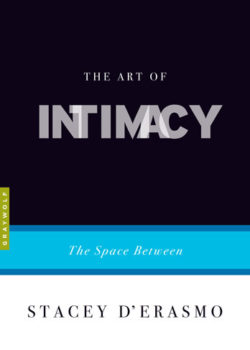Friendships, the bonds of parents and children, the fleeting communion of strangers at a dinner party or on a train or a plane, crushes, being deeply moved by art or by a historical event, the relationship between reader and writer: in all of these, that space between is vital, electric, and it often drives the story. Only connect, wrote Forster, and we do, for better and for worse; we exhort our characters to do the same.
—Stacey D’Erasmo, The Art of Intimacy
Most of us would agree that in our daily lives, safety is a good thing. It’s a good thing, for example, when it comes to airplane engines, or infant car seats, or those glassed-in viewing areas for tourists located high atop skyscrapers, one hundred stories in the air.
Alas, safety is not such a good thing when it comes to writing fiction.
I’ve been considering this contradiction since I began writing fiction. One of my MFA supervisors asked me, early on: “I wonder if you might be avoiding the ‘big moment’ of the story?”
“You’re right!” I said. “I’m skimming over the big moment.” I went back to my desk and worked on big moments.
Later, a writer friend suggested, “It sounds like you want to work on ‘taking risks’ this semester.”
“Yes,” I said, “risks!” So I took “risks”: I brazenly employed a shifting point of view. I daringly jumped back and forth in time.
Finally, another supervisor read a story I submitted to him, and in his response to me complimented its dialogue, pacing, and humor. Then he added that dreaded conjunction.
“But,” he wrote, “this is a very safe story.”
I understood that this was decidedly not a compliment. But what did he mean by “safe”?
“Why is it safe?” I asked. “And how do I fix it?”
After some back and forth, he and I realized that my playing it safe might in fact be an avoidance of difficult exposure for my characters. My stories were safe in part because I was protecting my characters from raw, intimate moments. Moreover, as a writer aiming for so-called “literary fiction,” I realized I was afraid of seeming low-brow; I was afraid of those dreaded unpolished descents: the descent into melodrama, the descent into sentimentality, the descent into embarrassingly bad sex writing.
Thus began a semester-long contemplation of narrative intimacy.
 So what exactly do I mean by “narrative intimacy”? I’m defining intimacy in fiction as any kind of close, powerful human connection conveyed on the page. The most obvious way this can manifest is through a connection between two characters—whether romantic, in the form of a physically intimate scene; or non-romantic, such as intense friendships, parent-child intimacy, even brief moments of emotional affinity between strangers. I also think narrative intimacy can include the deep connection possible between a person and a nonperson—such as experiencing an intense connection to music, art, or nature. Lastly, and importantly, I’m also including in my definition the connection a story can establish between a character and a reader—meaning a character exposes herself or himself not to others in the story, but only to the person reading the words on the page. It’s possible for us as readers to feel connected to a fictional character or narrator in a way that shares some of the intensity of our real-life human connections. This is a one-way form of intimacy, because obviously the character isn’t feeling a connection with us as we read, but I’m considering it a form of narrative intimacy all the same.
So what exactly do I mean by “narrative intimacy”? I’m defining intimacy in fiction as any kind of close, powerful human connection conveyed on the page. The most obvious way this can manifest is through a connection between two characters—whether romantic, in the form of a physically intimate scene; or non-romantic, such as intense friendships, parent-child intimacy, even brief moments of emotional affinity between strangers. I also think narrative intimacy can include the deep connection possible between a person and a nonperson—such as experiencing an intense connection to music, art, or nature. Lastly, and importantly, I’m also including in my definition the connection a story can establish between a character and a reader—meaning a character exposes herself or himself not to others in the story, but only to the person reading the words on the page. It’s possible for us as readers to feel connected to a fictional character or narrator in a way that shares some of the intensity of our real-life human connections. This is a one-way form of intimacy, because obviously the character isn’t feeling a connection with us as we read, but I’m considering it a form of narrative intimacy all the same.
Unfortunately, in our earliest fiction drafts, moments of intimacy often come off as ineffective, flat, false, or cliché, and we delete them, getting rid of those moments rather than trying to get them right.
Why is intense, close connection so challenging to convey in fiction? After all, intimate exposure is commonplace in our contemporary culture—from heart-on-sleeve social-media confessions; to omnipresent autobiographical pop songs; to pretty much every single episode of any addictive cable series. But it sometimes feels that we, as fiction writers, have it the hardest. (Poor us.) All those other forums have more tools at their disposal to convey intimacy: use of photographs, use of video, use of super-catchy background melodies. As writers we have nothing but words and a blank page. We must use only these to portray, as truthfully as possible, the intensity and universal emotional importance of human connection. And we can’t just acknowledge a connection; readers want to know how it feels, what it means, how it happened. Intimacy must be shown, expressed, made real somehow—again, using only printed words and white space.
How do we do it, and how do we do it well?
A writer can convey intimacy through confession, reflection, and gesture, and I’ll examine those three tools below. It’s helpful to be able to identify craft strategies in such a pointed way, but—spoiler alert—these three not enough. As always in good fiction, there’s that mysterious, hard-to-pin-down extra something that makes a scene succeed on the page. Here I’ll look at the way three different authors use confession, reflection, and gesture to convey intimacy, and I’ll also try to identify some of those extra elements—less precise, harder to articulate, but essential—that these authors employ to energize, even electrify, their characters’ moments of private exposure.
Alice Munro’s “Axis” is the story of two college-age couples and the seemingly minor decisions they make that determine, for better or for worse, the course of their futures. We’re told in the opening sentence that this story is set “fifty years ago” (probably in the late 1950s) and we are introduced to two characters: Avie, who is dating Hugo; and her friend Grace, who is dating Royce. The girls are waiting to take a bus home from college for the weekend—and we come to the first intimate moment of the narrative when the friends get on the bus and begin talking. Avie prepares to tell Grace about a dream she had, and she warns her friend: “You must never tell anybody.” In the dream she’s married to her boyfriend, Hugo, and she has a fussy, difficult baby, so she shuts the baby away in a dark cellar and forgets about it. After the recounting of the dream, Grace asks Avie, “What would Freud say? Never mind that, what would Hugo say? Have you told him?” And Avie replies, “Good God, no.”
 The moment represents a confession: Avie is ashamed of the dream, but she’s willing to admit it to her close friend. What makes this a successful intimate moment is both the placement of the scene—right at the start of the story—and the role of secrecy; Avie tells Grace she cannot share the dream with anyone else, revealing that she wouldn’t even tell her boyfriend.
The moment represents a confession: Avie is ashamed of the dream, but she’s willing to admit it to her close friend. What makes this a successful intimate moment is both the placement of the scene—right at the start of the story—and the role of secrecy; Avie tells Grace she cannot share the dream with anyone else, revealing that she wouldn’t even tell her boyfriend.
Dialogue can be a dynamic tool in the revelation of a character’s secrets, and this intimate moment is intensified by the fact that it happens through conversation. Munro begins “Axis” with one character confessing something to another, and this defines their relationship for the reader in swift, intriguing way. A character makes herself vulnerable just a few paragraphs into the story, which gets our attention. We wonder: what will she reveal next?
There are other vulnerable admissions in “Axis” that are not made out loud. This is character-reader intimacy: the third-person narrator shifts into an omniscient mode and reveals something about a character that only that character would know. For example, although Avie is dating and sleeping with Hugo, “The truth was that [Avie] would rather have had Grace’s boyfriend, Royce, who was a veteran of the Second World War.” Again, this is a secret, a flash of honesty, in the form of intimate reflection.
Directly following that sentence, we arrive at another example of reflection with insight into Grace’s view. Most of the story is from Avie or Royce’s perspective, so this is a surprising shift:
Unlike Avie, Grace was in love. She believed that her virginity and her refusal to let Royce dispose of it—not what he was used to—was a way of keeping him interested. But at times he was ready to give up on her, and to divert him from such bad moods she had learned to distract him with gossip or jokes about people like Hugo, whom he rather despised. In fact, Grace had got into the habit of making up stories about Hugo that weren’t anywhere near true. Both legs in one pant leg, after a session of harried lovemaking—nonsense like that. She hoped that Avie would never find out.
Here the omniscient narrator reveals one of Grace’s secrets. We now feel like we know and understand Grace better—she seems more human, more real, we feel more of a connection to her—because of this close-in moment. There’s something thrilling for the reader when an omniscient voice reveals something about a character that she would never reveal herself, and possibly never even admit to herself. We now know something the other characters don’t know. Despite my earlier complaints about the terrible hardships for writers in conveying intimacy on the page, this is where fiction writers may have a unique advantage. Omniscient insight into a character’s psyche is one of fiction’s great advantages. In our stories, we can allow readers to see into our characters’ minds and connect with them, even without those characters saying a word or making a single gesture. So maybe we can’t offer bright moving images or a snazzy soundtrack, but mind-reading is a pretty cool superpower, and that’s a gift we as writers are able give our readers.
In “Axis” we come to understand the character of Royce further, too, through his occasional moments of intimate reflection. Later in the story, on a summer trip to visit Grace at her family’s farm, he and Grace covertly go to bed together for the first time. They are caught in the act by Grace’s ill-tempered mother. Royce flees the house in frustration and anger, knowing he’ll have to hitchhike to get home, but too upset to try to get a ride:
He didn’t think he’d be able to talk to anybody. He remembered whispering to Grace the day before when they were doing the strawberries, kissing under the rush of cold water when her mother’s back was turned. Her fair hair turning dark in the stream of water. Acting as if he worshipped her. How at certain moments that had been true. The insanity of it, the insanity of letting himself be drawn. That family. That mad mother rolling her eyes to heaven.
This moment of reflection is an important humanizing moment for this character, because without it, Royce might be a fairly flat, possibly clichéd jerk character: He left Grace naked in the bedroom, ignoring her pleas to come with him, and later on, in the final scene of the story (running into Avie on a train, fifty years later), he comes across as insensitive and somewhat misogynistic. But that moment on the road has a sad beauty to it, a wistful honesty—“Acting as if he worshipped her. How at certain moments that had been true”—and this lingers briefly before returning to anger. Here and elsewhere, Munro’s moments of intimacy avoid cliché and flatness by acknowledging the duality of a character’s emotions. The fact that a character can have two seemingly opposed feelings at once adds depth and resonance. In abandoning his girlfriend, Royce simultaneously experiences tenderness and fury.
Munro also uses gesture to convey intimacy. By gesture I’m referring to anything ranging from a small physical act, such as a touch, to full a scene of physical action. In any case, it comes across as private and exposing for a character or characters. In “Axis,” the sex scene that lies at the center of the story certainly qualifies. Royce and Grace assume Grace’s family will be gone for the day at a sibling’s piano examination, finally giving them the opportunity to sleep together, marking the loss of Grace’s virginity. We get this scene from Royce’s point of view.
Her footsteps entered, very lightly, as if not to waken anyone sleeping in the house. Then a shy movement of the door, which, as he had already noted, had no locks of any kind. He stayed quite still, his eyes open just a slit. He gave her time. He had thought she might get into bed with her clothes on, but no. She was taking off every stitch in front of him, head bowed, lips pressed together, then moistened with her tongue. Very serious.
What a darling.
They were far enough advanced not to have heard the car. At first he had made quite an effort to be quiet, not because he believed in any danger but just because he meant to go easy, be very gentle with her. This notion, however, was on the point of being left behind. She didn’t seem to require such care. They were making enough noise themselves not to hear anything else.
This is strong use of description to describe physical intimacy, yet Munro cleverly opts to paint a clear picture of the couple’s first sexual encounter without describing a single body part in action. Rather than coming across as coy, or as avoiding physical details, this instead works in a trust-the-reader kind of way: she knows we know what’s happening—she doesn’t need to overexplain. She also successfully injects suspense into the scene—the image of the door without a lock during the couple’s illicit act adds distinct tension for the reader.
But perhaps the more moving intimate scene in “Axis” is the one following, after Grace’s mother walks in through the unlocked door and catches them in bed, flying into a rage and shouting at Royce:
[Royce] heaved Grace to one side without looking at her, reached down for his pants on the floor, and worked them on under the quilt before he got out of the bed. His movements kicked Grace away from him. He could not help that, hardly noticed it. She had her head buried in the sheets, her bare buttocks now somehow exposed.
“What have you done?” the mother said. “We take you into our family. We make you welcome in our home. Our daughter—”
“Your daughter makes up her mind for herself.”
“You hear him?” the mother cried at Grace’s buried head, her hands clutching at the dress she had put on specially for the piano examination. There wasn’t anywhere for her to sit down, except for the bed, and she couldn’t sit on that.
Royce responded to this by gathering the things that belonged to him, tidied up in Grace’s honor. Once he had to say “Excuse me” to the mother, but his tone was brutal.
When Grace heard him zip up his bag she turned over and put her feet on the floor. She was perfectly naked.
She said, “Take me. Take me with you.”
But he had gone out of the room, out of the house, as if he hadn’t even heard her.
First Grace’s “bare buttocks” are exposed in front of her mother, and then her full naked body is exposed, along with her palpable desperation (“take me with you”). Because of the characterization that has led up to this moment—of the mother (as judgmental and suspicious), of Grace (as deeply in love with Royce and hoping for marriage), of Royce (as frustrated with Grace’s history of sexual withholding)—we know how intensely uncomfortable this moment is, how fraught. This is intimacy through gesture and confession; we see Grace’s unclothed body sitting on the edge of the bed, and we hear her articulate her innermost desire.
“Axis” is in part a story of a young woman losing her virginity, being shamed by her mother, and being abandoned by a self-absorbed boyfriend whom she loved—an event that turns out to have implications for her entire life. In someone else’s hands, it could have been melodramatic, sentimental, and/or cringe-worthy. But it’s not. Why? The author skillfully handles surprise and suspense, critical ingredients of all stories and also particularly helpful in moments of narrative intimacy. Another strategy is modulation—the varying of tone or pitch. Munro’s moments of intimacy are never one note. They are both erotic and crude, tender and embarrassing, exciting and mundane. Munro uses contrasting images, language, and point of view to invoke scenes that involve a torrent of simultaneous emotions. By modulating these scenes tonally and otherwise, she creates on the page the closest feeling to being there, to being one of the characters. It’s an effort to duplicate the way it feels to feel many things at once, as we often do during intensely exposing experiences.
In writing intimate scenes, it can be easy to default to stereotypes, clichés, or culturally received assumptions. Again, this applies to all fiction writing, but it’s possible the task is all the more challenging when it comes to intimacy, something that appears everywhere and often in contemporary life. As a culture we sometimes accept certain ideas about human connection as “norms” without even realizing it. We might ask ourselves: am I, as a writer, unthinkingly embracing stereotypes about people, desire, and connection? Is there any way I could come at these assumptions or intimate situations from a new angle, if not question them altogether? This is both in the interest of being original and of being truthful. Stacey D’Erasmo’s The Art of Intimacy discusses this pitfall at length. She lists examples of “received ideas about intimacy,” such as: a built-in assumption that domestic heterosexual love, with children, is the default happy ideal for everyone. Or the culturally received assumption that certain races, ages, and body sizes don’t go together. She goes on:
One might also question easy gender stereotypes about intimacy: women only want love and men only want sex; women are better at intimacy than men; female friendship is always fraught with poisonous competitiveness, especially for male attention; mothers resent daughters; fathers abandon sons; women are needy and manipulative; men are disappointing and selfish; and so on. While one is at it, one could also question received ideas about sex and sexual identity: men are dogs and women are victims; sex within marriage is always boring and adultery is always thrilling but emotionally false; women are dying to get married; gay men are promiscuous and amusing; lesbians are hyperdomestic and faithful; bisexuals are untrustworthy tricksters who probably don’t even really exist … real sex is between people who are in love and any other kind of sex is shallow and empty; one-night stands make you feel sad and sticky the next day; men with younger partners are lucky and women with younger partners are pathetic and probably have had bad plastic surgery; mothers don’t have sex; fathers never get as much sex as they want and will inevitably turn to the (female, nubile, witless or sometimes conniving) babysitter . . . And so on.
Clearly D’Erasmo is mainly referring to romantic intimacy with this list of stereotypes, but there are plenty of cultural assumptions in all kinds of human connections that we could question as part of our writing process.







